To effectively write an event procedure for a control to respond to an event, it is necessary to configure specific properties that dictate its appearance and functionality. These properties can be set either through the properties window or dynamically during runtime.
In Figure 3.1, you'll find a standard properties window for a form. At the top, you'll see the currently selected object. The bottom part is divided into columns—the left lists various properties linked to the selected object, and the right displays their current states. To modify these properties, simply highlight and adjust the items in the right column by typing or selecting from the available options..

To modify the caption, simply highlight 'Form1' in the Caption section and replace it with your desired text. Additionally, you can customize the form's appearance by selecting either a 3D or flat style, adjusting foreground and background colors, changing the font type and size, toggling buttons for enable/disable, and managing minimize and maximize options, among other possibilities.
You may also change the properties at runtime to produce special effects such as change of color, shape, animation and more. Example 3.1 shows the code that will change the form color to red whenever the form is loaded. VB uses the hexadecimal system to specify the color. You can check the color codes in the properties windows corresponding to ForeColor and BackColor .
This example changes the background colour of the form using the BackColor property.
Private Sub Form_Load() Form1.Show Form1.BackColor = &H000000FF& End Sub
This example is to change the control's Shape using the Shape property. This code will change the shape to a circle at runtime.
Private Sub Form_Load() Shape1.Shape = 3 End Sub
We won't describe the details on how to set the properties just yet. However, please follow a few key points while configuring the properties.
Figure 3.2 is the toolbox that shows the basic controls.
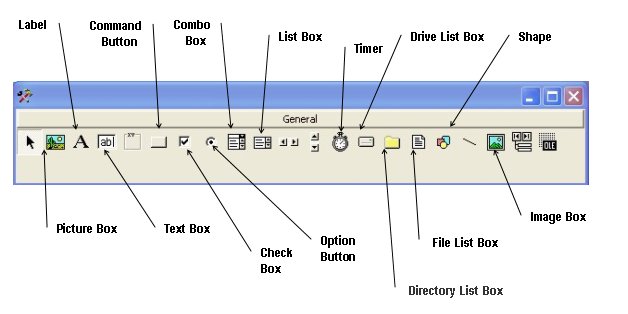
The text box is the standard control for accepting an input from the user and to display the output. It can handle string (text) and numeric data but not images or pictures. A string entered into a text box can be converted to a numeric data using the function Val(text). The following example illustrates a simple program that processes the input from the user.
In this program, two text boxes and a few labels and a command button were inserted onto the form together with . The two text boxes are to accept inputs from the user, one of the labels will display the sum of two numbers that are entered into the two text boxes. The command button is programmed to calculate the sum of the two numbers using the plus operator. The program uses a variable sum to accept the summation of values from text box 1 and text box 2.The procedure to compute the summation of two numbers is as follows.
Private Sub Command1_Click() 'To add the values in TextBox1 and TextBox2 Sum = Val(Text1.Text) +Val(Text2.Text) 'To display the answer on label 1 Label1.Caption = Sum End Sub
The output is shown in Figure 3.3

The label is for providing instructions and guides to the users, as well as for displaying outputs. One of its most important properties is Caption. Using the syntax Label.Caption, it can display text and numeric data . You can change its caption in the properties window and also at runtime. Please refer to Example 3.1 and Figure 3.1 for the usage of the label.
The command button is for executing a procedure triggered by an event initiated by the users. The most common event associated with the command button is the Click event, and the syntax for the procedure is
Private Sub Command1_Click () Statements End Sub
In this program, we want to crack a secret passoword entered by the user. In the design phase, insert a command button and change its name to cmd_ShowPass. Next, insert a TextBox and rename it as TxtPassword and delete Text1 from the Text property. Besides that, set its PasswordChr to *. Now, enter the following code in the code window.
Private Sub cmd_ShowPass_Click()
Dim yourpassword As String
yourpassword = Txt_Password.Text
MsgBox ("Your password is: " & yourpassword)
End Sub
Run the program and enter a password, then click on the Show Password button to reveal the password, as shown in Figure 3.4.

You can also reveal the password by setting the PasswordChr property back to normal mode, as follows:
Private Sub cmd_ShowPass_Click() Dim yourpassword As String Txt_Password.PasswordChar = "" End Sub
*Check out our more advanced password cracker program
The Picture Box is one of the controls that is used to handle graphics. You can load a picture at design phase by clicking on the picture item in the properties window and select the picture from the selected folder. You can also load the picture at runtime using the LoadPicture method. For example, the statement will load the picture grape.gif into the picture box.
Picture1.Picture=LoadPicture ("C:\VBprogram\Images\grape.gif")
In this program, insert a command button and a picture box. Enter the following code:
Private Sub cmd_LoadPic_Click()
MyPicture.Picture = LoadPicture("C:\Users\admin.DESKTOP-G1G4HEK\Documents\My Websites\vbtutor\vb6\images\uranus.jpg")
End Sub
* You must ensure the path to access the picture is correct. Besides that, the image in the picture box is not resizable. The output is shown in Figure 3.5
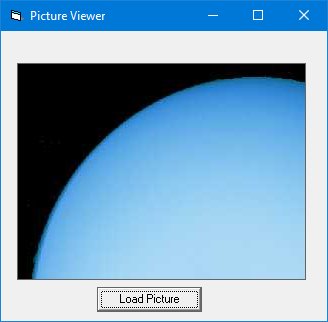
View our more advanced picture viewer here.
The Image Control is another control that handles images and pictures. It functions almost identically to the pictureBox. However, there is one major difference, the image in an Image Box is stretchable, which means it can be resized. This feature is not available in the PictureBox. Similar to the Picture Box, it can also use the LoadPicture method to load the picture. For example, the statement loads the picture grape.gif into the image box.
Image1.Picture=LoadPicture ("C:\VBprogram\Images\grape.gif")
In this program, we insert a command button and an image control into the form. Besides that, we set the image Strech property to true. Next, enter te following code:
Private Sub cmd_LoadImg_Click()
MyImage.Picture = LoadPicture("C:\Users\admin.DESKTOP-G1G4HEK\Documents\My Websites\vbtutor\vb6\images\uranus.jpg")
End Sub
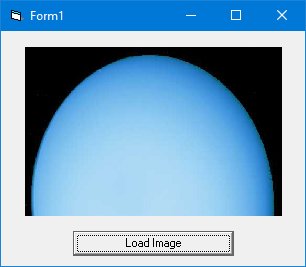
* Note the the difference between the image in Figure 3.5 and Figure 3.6.
The function of the ListBox is to present a list of items where the user can click and select the items from the list. In order to add items to the list, we can use the AddItem method. For example, if you wish to add a number of items to list box 1, you can key in the following statements
Private Sub Form_Load ( ) List1.AddItem “Lesson1” List1.AddItem “Lesson2” List1.AddItem “Lesson3” List1.AddItem “Lesson4” End Sub
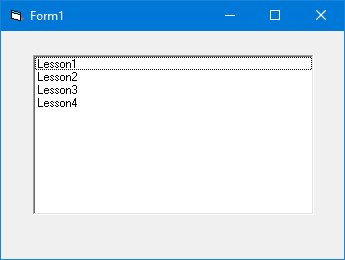
The items in the list box can be identified by the ListIndex property, the value of the ListIndex for the first item is 0, the second item has a ListIndex 1, and the third item has a ListIndex 2 and more.
The function of the Combo Box is also to present a list of items where the user can click and select the items from the list. However, the user needs to click the small arrowhead on the right of the combo box to see the items which are presented in a drop-down list. In order to add items to the list, you can also use the AddItem method. For example, if you wish to add a number of items to Combo box 1, you can key in the following statements
Private Sub Form_Load ( ) Combo1.AddItem "Item1" Combo1.AddItem "Item2" Combo1.AddItem "Item3" Combo1.AddItem "Item4" End Sub
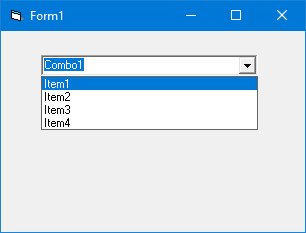
The Check Box control lets the user selects or unselects an option. When the Check Box is checked, its value is set to 1 and when it is unchecked, the value is set to 0. You can include the statements Check1.Value=1 to mark the Check Box and Check1.Value=0 to unmark the Check Box, as well as use them to initiate certain actions. For example, the program in Example 3.4 will show which items are selected in a message box.
Private Sub Cmd_OK_Click() If Check1.Value = 1 And Check2.Value = 0 And Check3.Value = 0 Then MsgBox "Apple is selected" ElseIf Check2.Value = 1 And Check1.Value = 0 And Check3.Value = 0 Then MsgBox "Orange is selected" ElseIf Check3.Value = 1 And Check1.Value = 0 And Check2.Value = 0 Then MsgBox "Orange is selected" ElseIf Check2.Value = 1 And Check1.Value = 1 And Check3.Value = 0 Then MsgBox "Apple and Orange are selected" ElseIf Check3.Value = 1 And Check1.Value = 1 And Check2.Value = 0 Then MsgBox "Apple and Pear are selected" ElseIf Check2.Value = 1 And Check3.Value = 1 And Check1.Value = 0 Then MsgBox "Orange and Pear are selected" Else MsgBox "All are selected" End If End Sub
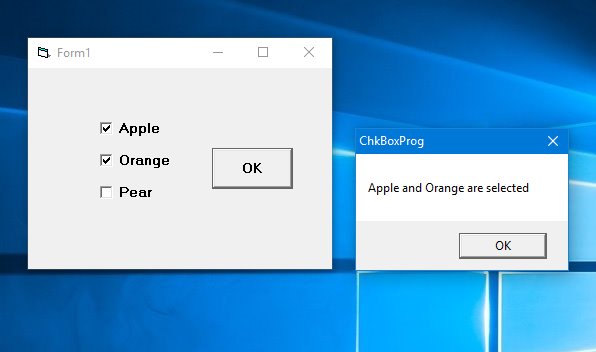
The OptionButton control also lets the user selects one of the choices. However, two or more Option buttons must work together because when one of the option buttons is selected, the other Option button will be unselected. In fact, only one Option Box can be selected at one time. When an option box is selected, its value is set to “True” and when it is unselected; its value is set to “False”.
In this example, we want to change the background color of the form according to the selected option. We insert three option buttons and change their captions to "Red Background","Blue Background" and "Green Background" respectively. Next, insert a command button and change its name to cmd_SetColor and its caption to "Set Background Color". Now, click on the command button and enter the following code in the code window:
Private Sub cmd_SetColor_Click() If Option1.Value = True Then Form1.BackColor = vbRed ElseIf Option2.Value = True Then Form1.BackColor = vbBlue Else Form1.BackColor = vbGreen End If End Sub
Run the program, select an option and click the "Set Background Color" produces the output, as shown in Figure 3.10.
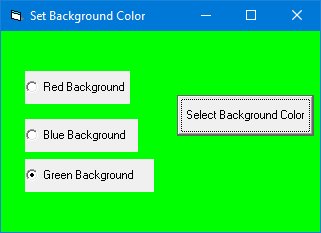
In this example, we inserted six option buttons. Turning the option buttons into a control array is a more effective approach, especially since they execute similar actions., i.e to change shape. In order to create a control array, click on the first option button, rename it as MyOption. Next, click on the option button and select copy then paste. After clicking the paste button, a popup dialog (Figure 3.11)will ask you whether you wish to create a control array, select yes. The control array can be accessed via its index value, MyOtion(Index. In addition, we also insert a shape control.
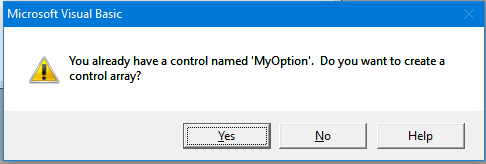
Now, enter the code in the code window. We use the If..Then..Else program structure to determine which option button is selected by the user. You can learn about If..Then..Else in Lesson 7.
Private Sub MyOption_Click(Index As Integer) If Index = 0 Then MyShape.Shape = 0 ElseIf Index = 1 Then MyShape.Shape = 1 ElseIf Index = 2 Then MyShape.Shape = 2 ElseIf Index = 3 Then MyShape.Shape = 3 ElseIf Index = 4 Then MyShape.Shape = 4 ElseIf Index = 5 Then MyShape.Shape = 5 End If End Sub
Run the program and you can change the shape of the shape control by clicking one of the option buttons. The output is shown in Figure 3.12.
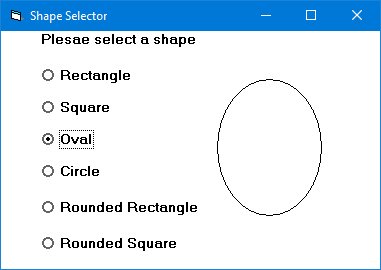
The DriveListBox is for displaying a list of drives available in your computer. When you place this control into the form and run the program, you will be able to select different drives from your computer as shown in Figure 3.13

The DirListBox means the Directory List Box. It is for
displaying a list of directories or folders in a selected drive. When you place
this control into the form and run the program, you will be able to select
different directories from a selected drive in your computer as shown in Figure
3.14

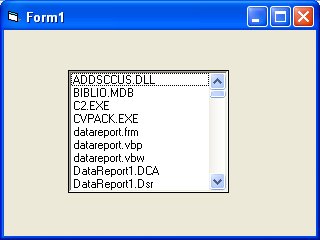
You can coordinate the Drive List Box, the Directory List Box and the File List Box to search for the files you want. The procedure will be discussed in later lessons.
Copyright©2008 Dr.Liew Voon Kiong. All rights reserved |Contact|Privacy Policy